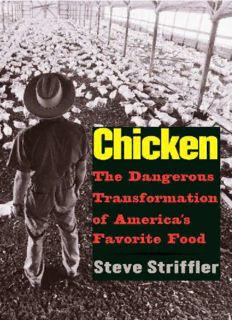
Chicken: The Dangerous Transformation of America's Favorite Food (Yale Agrarian Studies Series) PDF
Preview Chicken: The Dangerous Transformation of America's Favorite Food (Yale Agrarian Studies Series)
Chicken Chicken The Dangerous Transformation of America’s Favorite Food STEVE STRIFFLER Yale University Press New Haven and London Published with assistance from the Kingsley Trust Association Publication Fund established by the Scroll and Key Society ofYale College. Copyright © by Yale University. All rights reserved. This book may not be reproduced,in whole or in part,including illustrations,in any form (beyond that copying permitted by Sections and ofthe U.S.Copyright Law and except by reviewers for the public press),without written permission from the publishers. Set in Minion Roman type by Integrated Publishing Solutions. Printed in the United States ofAmerica by Vail-Ballou Press. Library ofCongress Cataloging-in-Publication Data Striffler,Steve,– Chicken :the dangerous transformation ofAmerica’s favorite food / Steve Striffler. p. cm.—(Yale agrarian studies series) Includes bibliographical references and index. ISBN ---(hardcover :alk.paper) . Chicken industry—United States—History.. Poultry plants— United States—History.. McDonald’s Corporation.I.Title.II. Yale agrarian studies. HD.US .''—dc A catalogue record for this book is available from the British Library. The paper in this book meets the guidelines for permanence and durability ofthe Committee on Production Guidelines for Book Longevity ofthe Council on Library Resources. Contents Preface vii Acknowledgments ix Introduction PARTI:A New Bird one Love That Chicken! two An American Industry three Anatomy ofa Merger four The Right to Work PARTII:A New Worker five Getting Here six Inside a Poultry Plant seven Growing Pains eight Toward a Friendlier Chicken Notes Index Preface It is my first day ofwork in one ofthe largest poultry-processing plants in the world.I am given “the tour”that all new workers receive.We begin in live hanging. Hundreds of live chickens flood offthe trucks,down a chute,and into a bin where work- ers quickly hang them by their feet onto the production line. It’s surreal.It is nearly pitch black,on the theory that the dark- ness soothes the terrified birds.The smell and look ofthe place are oppressive,so I look for something to focus on other than the hanging itself.A worker.I eventually learn that Javier is from Mexico,but the figure is hard to make out at first.He is cov- ered from head to toe in protective clothing that is itselfcoated with blood,shit,and feathers.Javier’s job is simple,ifsomewhat gruesome.The chickens have already passed through scalding hot water and have been electrocuted, a process designed to both kill the bird and begin the cleaning. Neither task is ac- complished perfectly.The communal baths,popularly known as fecal soups,do clean,but they also pass harmful microbes from one bird to the next.The bath also doesn’t do a particu- larly good job ofkilling the chickens:one out ofevery twenty seems to make it through alive.The birds are in their last stages of life when they reach Javier.For eight hours a day he sits on viii Preface a stool, knife in hand, and stabs the few chickens that have managed to hold onto life. While watching Javier, I realize what this book will be about. How did Javier and the chickens arrive in this place, under these conditions? Where do they go once they leave the plant? And what does their experience in the plant mean to those ofus who eat chicken? The search for answers led me to study a period when chickens were raised and processed quite differently, and to visit poultry farms, supermarkets, restau- rants,and communities in the southern United States and cen- tral Mexico.As I learned while doing this research,whereas the chicken’s journey is one characterized by uniformity and pre- dictability,the worker’s path is defined by variation,insecurity, and chaos. Neither experience leads to a particularly healthy outcome for bird,worker,farmer,environment,or consumer. I do not feel sorry for Javier or the chickens.I have worked in a plant before,and stabbing chickens is a relatively easy job. Many workers would be glad to trade places.And the chickens are there to die.I knew this going in.The problem,which be- came more transparent as I passed by “evisceration,”the “KFC line,”and the “wing room,”was that no one departed from the plant in particularly good shape. The workers left poor, ex- hausted, and, in many cases, seriously injured. The chickens not only exited the plant dead,but in a “further-processed”form that was not particularly healthy for consumers.In short,the postwar promise ofthe industrial chicken—as a healthy,plen- tiful alternative to beef—has been lost for all ofthe people in- volved in its raising,processing,and consumption.There has to be a better way. Acknowledgments I used to eat chicken without much thought about where it came from,or how and by whom it was raised and processed. Life was much easier then.For complicating my dinner,giving me an education,and allowing me to write this book,I thank a number ofpeople.I begin with everyone involved in the in- dustry,including workers,farmers,managers,and many others, who took the time to share their stories and knowledge.I have the greatest respect for the work you do.Libraries and librarians were also a key part ofthis long process,particularly those as- sociated with Wilkes Community College,Wilkes County Pub- lic Library,Shiloh Museum,and the University ofArkansas.The year I spent as a Rockefeller Fellow at the University Center for International Studies at the University of North Carolina at Chapel Hill gave me precious time to read,write,and think in a stimulating atmosphere.Many thanks to Don Nonini,James Peacock, Niklaus Steiner, Ajantha Subramanian, Harry Wat- son,and many others for making this possible.Leon Fink’s en- couragement,as well as his own work,has been crucial to this project. Bill Roseberry, who died before a page of this book was written,remains a guiding force.His advice and assistance during the project’s early stages were inspirational.
Description: